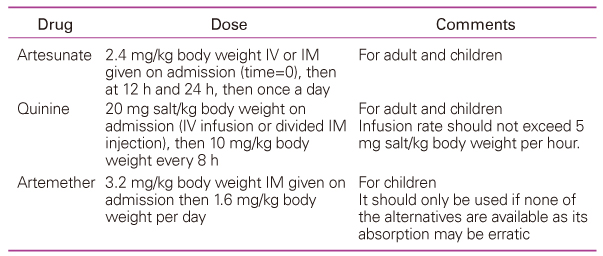 |
 |
- Search
| J Korean Med Assoc > Volume 55(1); 2012 > Article |
Abstract
Parasitic diseases are widely distributed throughout the world. Recently, travel abroad and migration from abroad are increasing in Korea. Therefore, it is necessary to appropriately control imported parasitic disease. The drugs for the treatment of the parasitic diseases that can be imported from abroad are reserved by the government. To guide proper treatment of parasitic diseases, recommended chemotherapy focused on these reserved drugs has been introduced. The diseases reviewed in this article include malaria, babesiosis, toxoplasmosis, leishmaniasis, Chagas disease, African sleeping sickness, filariasis, angiostrongyliasis, and fascioliasis. Because most of the parasitic diseases produce severe illness or fatal results, rapid and accurate diagnosis is important and following fully the recommended therapy is needed. The recommended drug therapy changes from time to time due to various factors, so always recognizing and applying the latest therapy and is very important.
References
1. Ministry of Health and Welfare. Korea Center for Disease Control and Prevention. Korean Medical Association. Ministry of Health and Welfare. Korea Center for Disease Control and Prevention. Korean Medical Association. Summary of infectious diseases designated by law. Case definitions for national notifiable infectious diseases 2010;Seoul: Munyoungsa. 2-30.
2. Ministry of Health and Welfare. Korea Center for Disease Control and Prevention. Korean Medical Association. Ministry of Health and Welfare. Korea Center for Disease Control and Prevention. Korean Medical Association. Appendix 4. List of rare medicines for treatment of imported parasitic diseases. Case definitions for national notifiable infectious diseases 2010;Seoul: Munyoungsa. 308.
3. World Health Organization. World Health Organization. Antimalarial medicines. WHO model formulary 2008 2009;Geneva: WHO Press. 186-203.
4. World Health Organization. World Health Organization. Clinical disease and epidemiology. Guidelines for the treatment of malaria 2010;2nd ed. Geneva: WHO Press. 4-5.
5. World Health Organization. World Health Organization. Health-related millennium development goals. World health statistics 2011 2011;Geneva: WHO Press. 12-21.
6. Ministry of Health and Welfare. Korea Center for Disease Control and Prevention. Ministry of Health and Welfare. Korea Center for Disease Control and Prevention. 2010 Summary of infectious diseases surveillance. Infectious diseases surveillance yearbook 2010 2011;Seoul: Munyoungsa. 15-44.
7. Kappagoda S, Singh U, Blackburn BG. Antiparasitic therapy. Mayo Clin Proc 2011;86:561-583.
8. Dubey JP, Jones JL. Toxoplasma gondii infection in humans and animals in the United States. Int J Parasitol 2008;38:1257-1278.
9. Haldar AK, Sen P, Roy S. Use of antimony in the treatment of leishmaniasis: current status and future directions. Mol Biol Int 2011;2011:571242.
10. Maya JD, Orellana M, Ferreira J, Kemmerling U, Lopez-Munoz R, Morello A. Chagas disease: Present status of pathogenic mechanisms and chemotherapy. Biol Res 2010;43:323-331.
11. Ramirez-Avila L, Slome S, Schuster FL, Gavali S, Schantz PM, Sejvar J, Glaser CA. Eosinophilic meningitis due to Angiostrongylus and Gnathostoma species. Clin Infect Dis 2009;48:322-327.
12. Kliks MM, Kroenke K, Hardman JM. Eosinophilic radiculomyeloencephalitis: an angiostrongyliasis outbreak in American Samoa related to ingestion of Achatina fulica snails. Am J Trop Med Hyg 1982;31:1114-1122.
13. Robinson MW, Dalton JP. Zoonotic helminth infections with particular emphasis on fasciolosis and other trematodiases. Philos Trans R Soc Lond B Biol Sci 2009;364:2763-2776.
14. Fairweather I. Triclabendazole: new skills to unravel an old(ish) enigma. J Helminthol 2005;79:227-234.
Table 2
Summary of initial parenteral treatment of severe malaria [4]

From World Health Organization. Guidelines for the treatment of malaria. 2nd ed. Geneva: WHO Press; 2010 [4].
IV, intravenous; IM, intramuscular.
Table 3
Summary of follow-on treatment of severe malaria

From World Health Organization. Guidelines for the treatment of malaria. 2nd ed. Geneva: WHO Press; 2010 [4].
- TOOLS
-
METRICS

-
Related articles in
J Korean Med Assoc -
Pharmacotherapy for patients with diabetes mellitus2020 December;63(12)
Chemotherapeutic drugs for common parasitic diseases in Korea2013 June;56(6)
Pharmacotherapy for chronic obstructive pulmonary disease2018 September;61(9)
Pharmacotherapy for chronic obstructive pulmonary disease2019 May;62(5)






